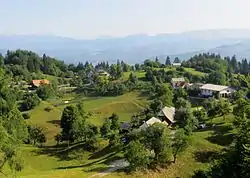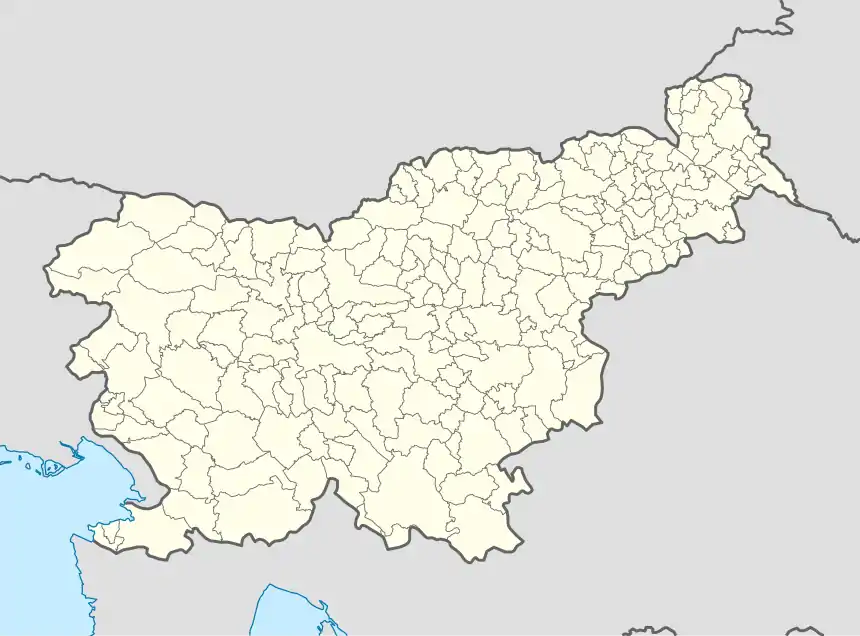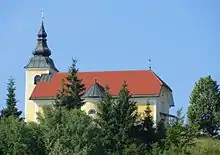Katarija
Katarija (pronounced [kataˈɾiːja]) is a settlement in the hills south of Moravče in central Slovenia. The area is part of the traditional region of Upper Carniola. It is now included with the rest of the Municipality of Moravče in the Central Slovenia Statistical Region.[2] In addition to the main settlement, it includes the hamlets of Vrh Svetega Miklavža and Grmače.[3]
Katarija | |
|---|---|
 | |
 Katarija Location in Slovenia | |
| Coordinates: 46°6′40.29″N 14°44′35.07″E | |
| Country | |
| Traditional region | Upper Carniola |
| Statistical region | Central Slovenia |
| Municipality | Moravče |
| Area | |
| • Total | 1.01 km2 (0.39 sq mi) |
| Elevation | 701.9 m (2,302.8 ft) |
| Population (2002) | |
| • Total | 41 |
| [1] | |
History
During the Second World War, there was a Partisan checkpoint at the Lazar house in the village; other Partisan activities included a bunker established in August 1942 for treating the wounded. On 13 August 1944 German forces burned the main settlement and the hamlet of Grmače, as well as two houses in Vrh Svetega Miklavža. A Partisan monument was unveiled in Grmače in 1953.[3]
Church

The local church is dedicated to Saint Nicholas and belongs to the Parish of Moravče. It dates to the mid-15th century.[4] Saint Nicholas was the patron of boatmen on the Sava River. It was referred to as the "Guardian of the Upper Sava" (Slovene: čuvar zgornje Save) because the boatmen believed that they were protected as long as they had the church in their sight. The church is vaulted, with a rectangular nave and a shallow chancel. Tradition states that the church was built to replace an older church that stood in Velika Vas but was burned by Ottoman forces. A less accessible location was selected for the new church, at a site where a pagan temple formerly stood.[5] The remains of a fortified wall surround the church, and the building has frescoes dating from the 15th and 16th centuries that have been whitewashed over. The main altar features a painting by Franz Götzl and the side altars have Baroque paintings.[3]
Other cultural heritage
In addition to Saint Nicholas' Church, several other sites in Katarija are registered as cultural heritage:
- The Vrh Svetega Miklavža archaeological site contains traces of prehistoric and late Roman-era settlement, as well as a medieval fortified wall.[6]
- The Grmače chapel-shrine is a closed structure with a tiled roof topped by a cast-iron cross. The niche contains a statue of Our Lady, Star of the Sea (Slovene: Marija zvezde). The front of the shrine features a profiled cornice, decorative tassels, and pilasters. It dates from the first half of the 19th century and stands at the crest of the hill in Grmače.[7]
- A chapel-shrine dedicated to Our Lady of Sorrows stands on the edge of the woods along the former route to Saint Nicholas' Church. It is a closed masonry shrine with a gabled roof covered with concrete tiles and dates from the second half of the 19th century. It formerly contained a wooden folk statue of Our Lady of Sorrows; today it contains a painting of the Pietà.[8]
- The Mežnar chapel-shrine stands along the road below Saint Nicholas' church. It is a square, closed masonry shrine with a gabled roof. Its semicircular niche contains a statue of the Virgin Mary, and the sides feature paintings of Saint Nicholas and Saint Martin. It dates from the mid-19th century.[9]
- There is a Partisan monument in Grmače that commemorates Partisan soldiers that fell during the Second World War and other victims of the occupying forces. It was erected in 1953.[10]
 Grmače chapel-shrine
Grmače chapel-shrine Our Lady of Sorrows chapel-shrine
Our Lady of Sorrows chapel-shrine Mežnar chapel-shrine
Mežnar chapel-shrine
References
- Statistical Office of the Republic of Slovenia Archived November 18, 2008, at the Wayback Machine
- Moravče municipal site
- Savnik, Roman, ed. 1971. Krajevni leksikon Slovenije, vol. 2. Ljubljana: Državna založba Slovenije, p. 89.
- Slovenian Ministry of Culture register of national heritage reference number ešd 2062
- Sveti Miklavž nad Savo. Information sign at the church.
- Slovenian Ministry of Culture register of national heritage reference number ešd 10154
- Slovenian Ministry of Culture register of national heritage reference number ešd 29379
- Slovenian Ministry of Culture register of national heritage reference number ešd 29377
- Slovenian Ministry of Culture register of national heritage reference number ešd 29378
- Slovenian Ministry of Culture register of national heritage reference number ešd 29110
External links
 Media related to Katarija at Wikimedia Commons
Media related to Katarija at Wikimedia Commons- Katarija on Geopedia
